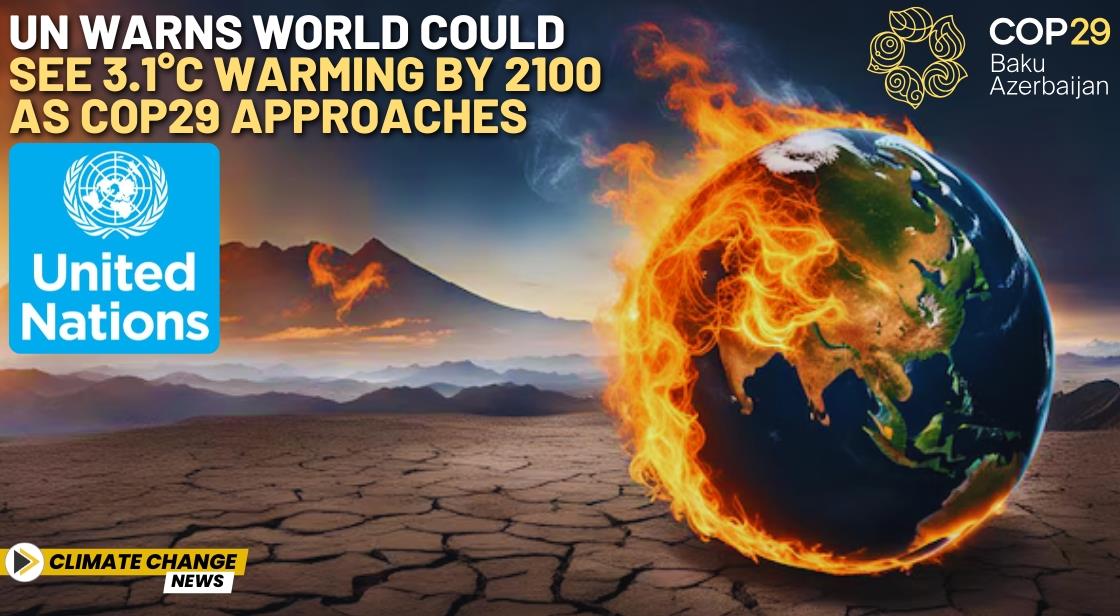UN Warns World Could See 3.1°C Warming by 2100 as COP29 Approaches

News Synopsis
A recent United Nations report has issued a grave warning, predicting that if countries continue with their current environmental policies, global temperatures will rise by 3.1 degrees Celsius above pre-industrial levels by the end of the century.
This serves as a crucial wake-up call for nations to urgently accelerate their climate action efforts. The report clearly signals that the world is collectively on the brink of missing the targets outlined in the Paris Agreement, where nations committed to limiting global warming to well below 2°C, with efforts to cap it at 1.5°C.
The UN Emissions Gap Report 2024 titled: "The Emissions Gap Report 2024: No More Hot Air... Please!" was released on Thursday ahead of the COP29 summit, set to be held in Baku, Azerbaijan from November 11 to 22.
The report illustrates that even full implementation of Nationally Determined Contributions (NDCs)—both unconditional and conditional—would only marginally reduce emissions by 2030. This would lead to a global temperature increase of up to 2.6°C under the most optimistic scenario, and 2.8°C if only current policies continue.
The report not only reveals the current inadequacy of global climate efforts but also highlights the rise in greenhouse gas emissions (GHG). Emissions increased by 1.3% in 2023, surpassing the average growth rate of 0.8% per year in the decade leading up to the COVID-19 pandemic. According to the report's authors, the world is in a worse position now compared to previous decades when it comes to combating climate change.
GHG Emissions Must Fall Significantly by 2030
The report underscores the drastic emission reductions required to meet global warming targets. To keep warming below 1.5°C, emissions must fall by 42% by 2030, relative to 2019 levels. For the 2°C target, a reduction of 28% is necessary. By 2035, these reductions must rise to 57% for the 1.5°C target and 37% for the 2°C target.
"Climate crunch time is here," said Inger Andersen, Executive Director of the United Nations Environment Programme (UNEP), in a statement. "We need global mobilisation on a scale and pace never seen before—starting right now, before the next round of climate pledges—or the 1.5 degrees C goal will soon be dead, and even well below 2°C will face extreme challenges."
Andersen further urged global leaders to use the upcoming COP29 talks to escalate their climate actions, push for stronger NDCs, and set the world on the path to a 1.5°C warming limit.
G20 Countries Fall Short on Climate Promises
The G20 countries, minus the African Union, are responsible for a staggering 77% of global emissions. In 2023, greenhouse gas emissions across these major economies increased, with the six largest GHG emitters contributing 63% of global emissions. In stark contrast, least developed countries (LDCs) accounted for only 3% of total emissions.
The report further points to large disparities in per capita emissions. For instance, India's total GHG emissions rose by 6.1% in 2022-23, but its per capita emissions stood at 2.9 tCO2e/capita—much lower than China’s (11 tCO2e/capita) and the US (18 tCO2e/capita).
"Average per capita GHG emissions are nearly three times higher than the global average of 6.6 tCO2e in the US and Russian Federation, while emissions remain significantly below the global average in regions like the African Union, India, and other least developed nations," the report noted.
Potential for Change: Solar, Wind, and Forest Conservation
Despite the bleak outlook, the report highlights several viable pathways to bridge the emissions gap. It suggests that scaling up solar photovoltaic and wind energy could contribute 27% of the total reduction potential by 2030 and 38% by 2035. Additionally, increasing forest conservation efforts could deliver 20% of the required reductions in both timeframes.
The report stresses the need for a transition away from fossil fuels and the importance of tripling renewable energy capacity by 2030, alongside doubling the global rate of energy efficiency improvements. Implementing these measures, coupled with the protection and restoration of natural ecosystems, could help the world meet its climate goals.
In conclusion, while the UN report paints a sobering picture of the climate crisis, it also offers hope that with immediate, concerted action, the world can still avoid the worst impacts of global warming. COP29 presents a critical opportunity for global leaders to renew their commitments and take decisive steps toward a sustainable future.
Conclusion:
The latest United Nations report ahead of COP29 underscores the urgency of the climate crisis, highlighting the inadequacy of current national commitments and the risk of surpassing a 3.1°C global temperature increase by the end of the century.
Despite ambitious pledges from major economies and global targets set by the Paris Agreement, the world remains significantly off track. With greenhouse gas emissions reaching record highs and the emissions gap widening, particularly among G20 nations, immediate and transformative action is necessary.
The report stresses that achieving the necessary reductions in emissions by 2030 is possible, but only if there is a substantial, collective shift toward renewable energy, enhanced efficiency, and nature conservation.
As COP29 convenes in Baku, Azerbaijan, the world’s leaders face a pivotal opportunity to recalibrate their strategies and commit to concrete actions that can still steer the planet toward a 1.5°C pathway. Failure to act decisively will likely result in irreversible climate impacts, emphasizing that the time to mobilize is now.
You May Like









